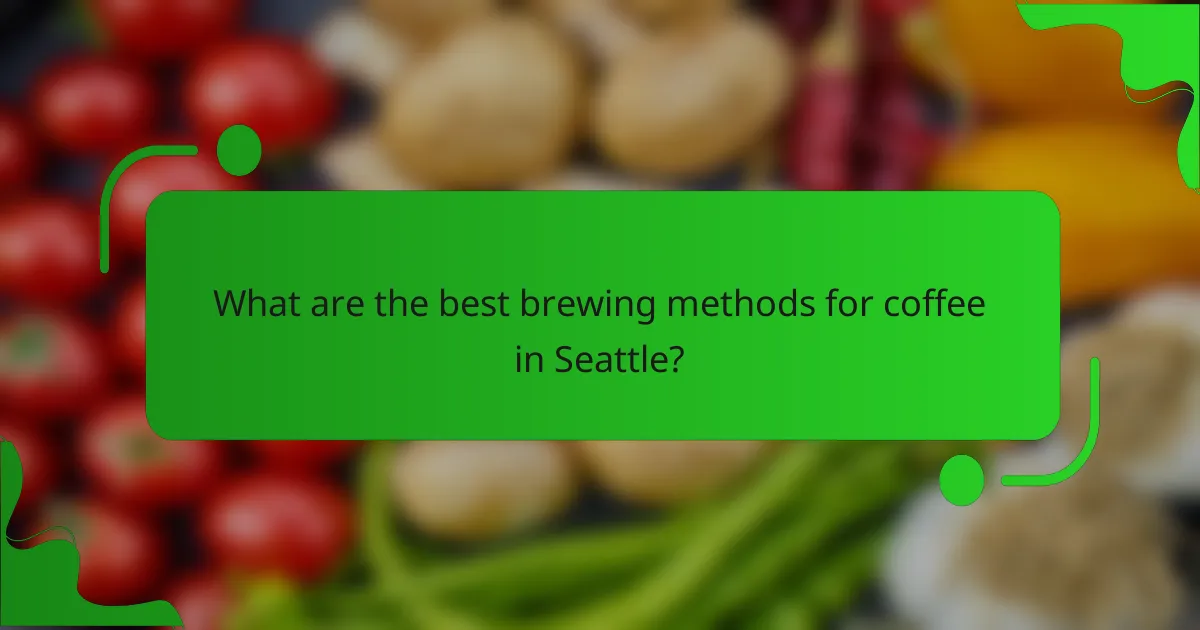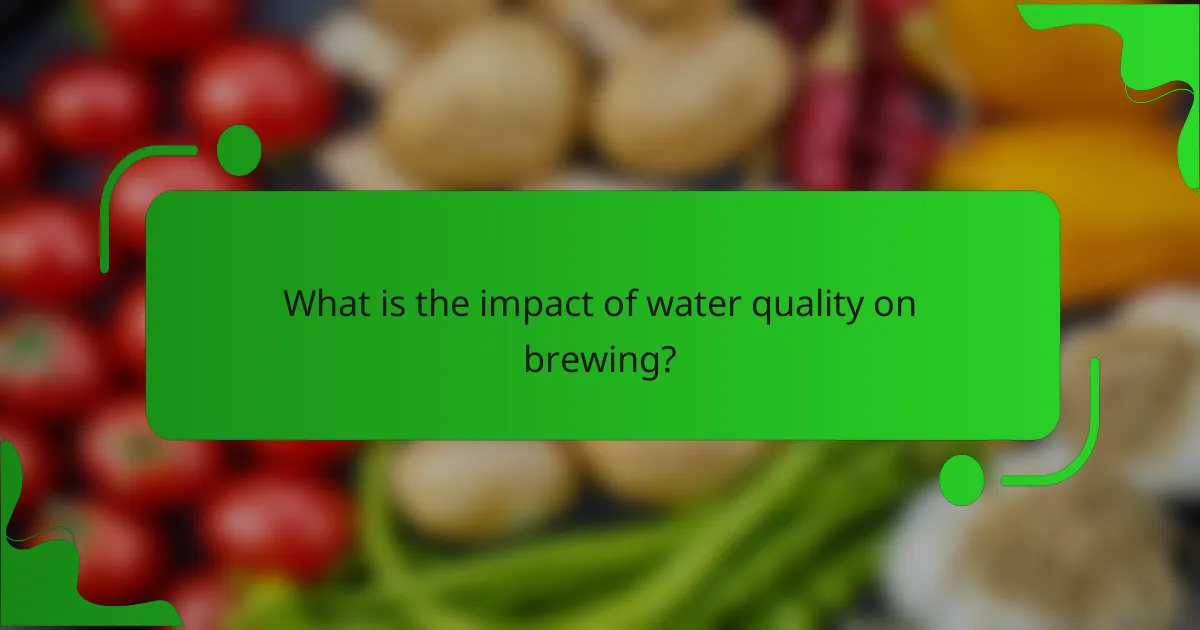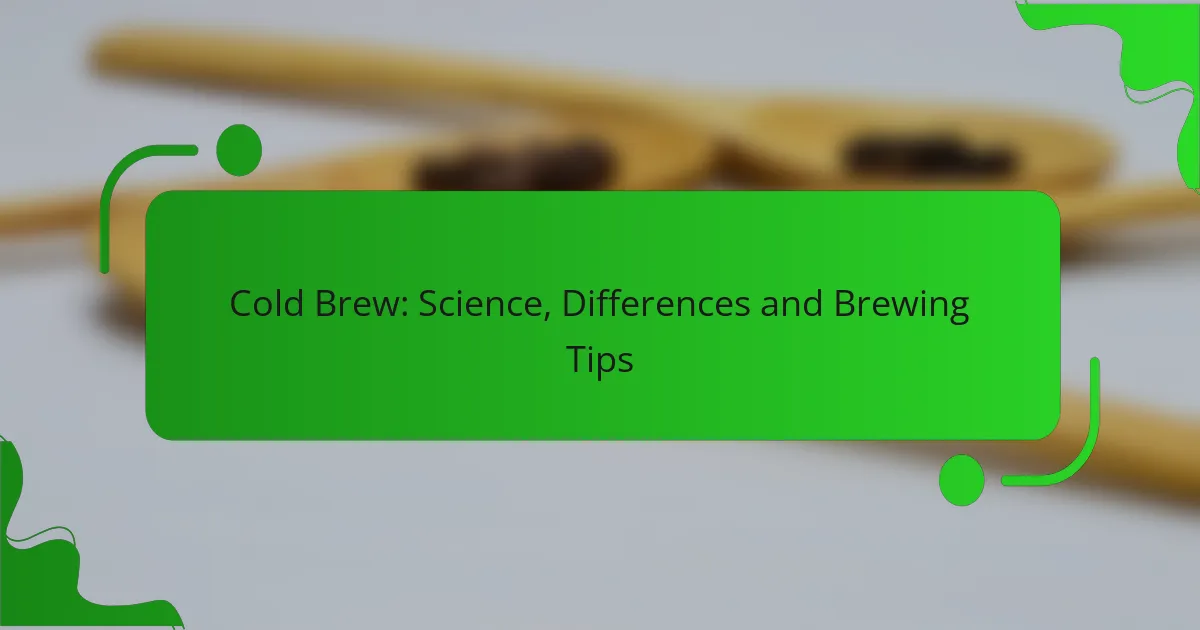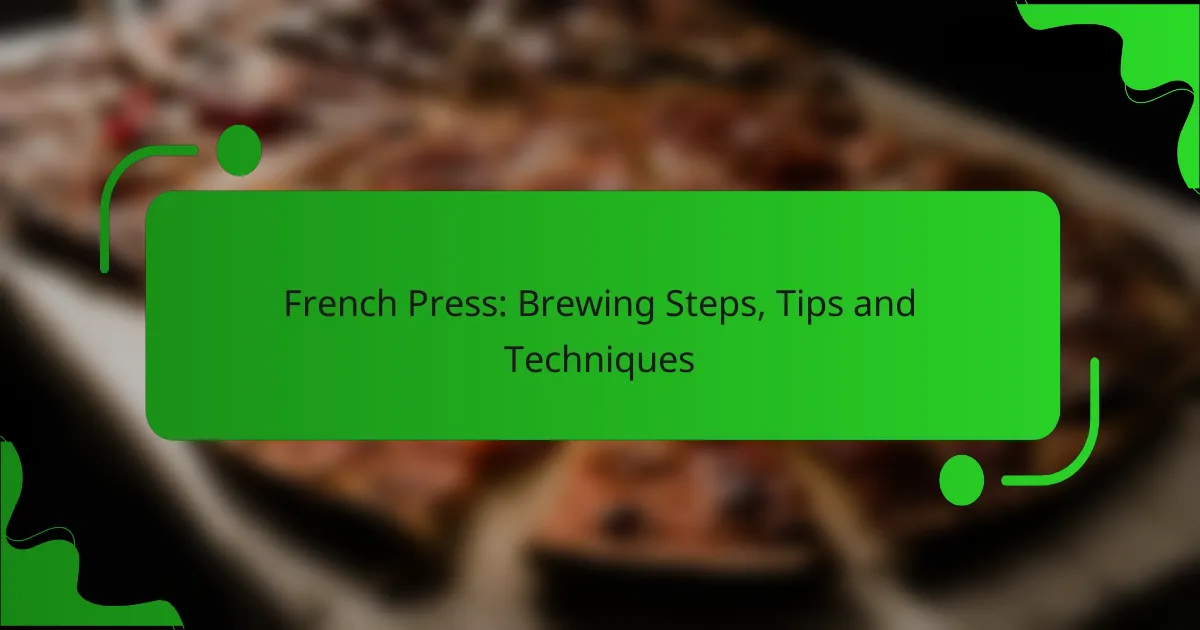Brewing methods play a vital role in shaping the flavor and experience of coffee, with techniques like pour-over, French press, and espresso each offering distinct characteristics. Factors such as extraction time, water temperature, and grind size are crucial in determining the final taste, making it essential for coffee enthusiasts to understand these variables. By exploring different brewing techniques, one can enhance their coffee experience and discover personalized flavors that cater to their preferences.

What are the best brewing methods for coffee in Seattle?
The best brewing methods for coffee in Seattle include pour-over, French press, espresso, Aeropress, and cold brew. Each method offers unique flavors and experiences, catering to the diverse coffee culture in the city.
Pour-over coffee
Pour-over coffee involves manually pouring hot water over coffee grounds in a filter. This method allows for precise control over brewing time and temperature, resulting in a clean and flavorful cup. Popular pour-over devices include the Hario V60 and Chemex, both of which are widely available in Seattle coffee shops.
To achieve the best results, use a coffee-to-water ratio of about 1:15 and aim for a brewing time of 2-4 minutes. Avoid using water that’s too hot, as it can lead to bitter flavors.
French press
The French press, or press pot, brews coffee by steeping coarsely ground coffee in hot water for several minutes before pressing down a metal or plastic plunger. This method extracts rich oils and flavors, resulting in a full-bodied cup. It’s a favorite among those who enjoy a robust coffee experience.
For optimal brewing, use a coffee-to-water ratio of 1:12 and steep for about 4 minutes. Be cautious not to steep for too long, as it can lead to over-extraction and bitterness.
Espresso
Espresso is a concentrated coffee brewed by forcing hot water through finely-ground coffee under high pressure. This method produces a small, intense shot of coffee, often served as a base for drinks like lattes and cappuccinos. Seattle’s coffee scene is known for its quality espresso, making it a staple for many coffee lovers.
To make espresso, use a coffee-to-water ratio of about 1:2 and aim for a brewing time of 25-30 seconds. Invest in a good espresso machine and grinder for the best results, as equipment quality significantly impacts flavor.
Aeropress
The Aeropress is a versatile brewing device that combines immersion and pressure to extract coffee. It is compact and easy to use, making it popular among coffee enthusiasts in Seattle. The resulting coffee can be strong and smooth, depending on the brewing technique.
For a balanced cup, use a coffee-to-water ratio of 1:15 and steep for about 30 seconds before pressing. Experiment with different grind sizes and brewing times to find your preferred flavor profile.
Cold brew
Cold brew coffee is made by steeping coarsely ground coffee in cold water for an extended period, typically 12-24 hours. This method results in a smooth, less acidic coffee that is refreshing, especially during Seattle’s warmer months. Cold brew can be served straight or mixed with milk or sweeteners.
For a strong cold brew concentrate, use a coffee-to-water ratio of 1:4. After steeping, strain the coffee through a fine mesh or coffee filter to remove the grounds. Store the concentrate in the refrigerator for up to two weeks.

How do different brewing techniques affect flavor?
Different brewing techniques significantly influence the flavor profile of the final beverage. Factors such as extraction time, water temperature, and grind size all play crucial roles in determining how flavors are extracted from the coffee or tea grounds.
Extraction time
Extraction time refers to the duration that water is in contact with the coffee or tea grounds. Longer extraction times can lead to a more intense flavor, but may also result in bitterness if over-extracted. For coffee, a typical range is between 20 seconds to 4 minutes, depending on the brewing method.
For instance, espresso requires a short extraction time of about 25-30 seconds, while French press brewing may take around 4 minutes. Adjusting the extraction time can help balance the flavors, so it’s important to experiment to find the optimal duration for your preferred taste.
Water temperature
Water temperature is another critical factor that affects flavor extraction. Generally, hotter water extracts flavors more quickly, but if the temperature is too high, it can lead to undesirable bitterness. A typical range for brewing coffee is between 90°C to 96°C (194°F to 205°F).
For delicate teas, such as green tea, lower temperatures around 70°C to 80°C (158°F to 176°F) are often recommended to preserve their subtle flavors. Monitoring water temperature can help achieve the desired taste profile, so using a thermometer can be beneficial.
Grind size
Grind size impacts the surface area of the coffee or tea grounds, which in turn affects extraction. Finer grinds expose more surface area, allowing for quicker extraction, while coarser grinds slow down the process. For example, espresso requires a fine grind, while French press uses a coarse grind.
Choosing the right grind size is essential for balancing flavor and avoiding over or under-extraction. A general rule of thumb is to match the grind size with the brewing method: finer for quick methods and coarser for longer steeping times. Experimenting with grind sizes can help you discover the best flavor for your brew.

What are the benefits of using a French press?
Using a French press offers several advantages, including enhanced flavor extraction and a rich, full-bodied coffee experience. This method allows for greater control over brewing time and temperature, resulting in a personalized cup of coffee.
Rich flavor profile
The French press method is renowned for producing a rich flavor profile due to its immersion brewing technique. Coffee grounds steep directly in hot water, allowing oils and fine particles to remain in the brew, which enhances the overall taste. This results in a more robust and aromatic cup compared to other brewing methods.
To maximize flavor, use coarsely ground coffee and steep for about four minutes. Experimenting with different coffee beans can also yield varied flavor notes, making each cup unique.
Full-bodied texture
A French press coffee has a full-bodied texture that many coffee enthusiasts appreciate. The absence of paper filters allows more natural oils and sediments to pass into the final brew, contributing to a thicker mouthfeel. This characteristic can make the coffee feel more satisfying and indulgent.
For an optimal experience, ensure the coffee is ground to the right coarseness and avoid over-extraction by adhering to recommended brewing times. This balance will enhance the body without introducing excessive bitterness.
Cost-effective
Using a French press is a cost-effective brewing method, as it requires minimal equipment and no need for disposable filters. A quality French press can be purchased for a modest price, and the ongoing costs are limited to coffee and water.
Additionally, brewing coffee at home with a French press can save money compared to purchasing specialty coffee drinks. This method allows for larger batches, making it ideal for serving multiple cups without significant expense.

What is the impact of water quality on brewing?
Water quality significantly affects brewing, influencing flavor, aroma, and overall quality of the final product. Factors such as mineral content, pH levels, and temperature consistency play crucial roles in determining how well ingredients interact during the brewing process.
Mineral content
The mineral content of water can enhance or detract from the brewing process. Key minerals like calcium, magnesium, and sulfate contribute to the extraction of flavors from the grains and hops. For example, higher calcium levels can improve clarity and stability in beer, while sulfate can accentuate bitterness.
Brewers often aim for specific mineral profiles depending on the style of beer being produced. For instance, a pale ale may benefit from higher sulfate levels, while a stout might require more chloride to enhance sweetness. Regular testing of water sources can help brewers adjust mineral content effectively.
pH levels
The pH level of water impacts enzymatic activity during mashing, which is crucial for converting starches into fermentable sugars. Ideally, the pH should be between 5.2 and 5.6 for optimal enzyme performance. A pH that is too high or too low can lead to poor extraction and undesirable flavors.
Brewers can adjust pH using food-grade acids or bases, such as lactic acid or sodium bicarbonate. Monitoring pH throughout the brewing process is essential, as it can change during mashing and boiling, affecting the final product’s taste and stability.
Temperature consistency
Consistent water temperature is vital for maintaining control over the brewing process. Fluctuations can lead to uneven extraction of flavors and sugars, resulting in inconsistent beer quality. Ideally, water temperature should be maintained within a narrow range during mashing, typically around 65-70°C (149-158°F).
Brewers should invest in reliable temperature control systems to ensure stability throughout the brewing process. Using insulated mash tuns and monitoring equipment can help maintain the desired temperature, leading to better flavor profiles and overall quality in the final brew.

How to choose the right brewing method for your taste?
Choosing the right brewing method depends on your personal flavor preferences, the equipment you have available, and the time you can dedicate to brewing. Each method offers unique characteristics that can enhance or alter the taste of your beverage, so consider what suits your palate best.
Personal flavor preferences
Your flavor preferences play a crucial role in selecting a brewing method. For instance, if you enjoy bold and rich flavors, methods like French press or espresso might appeal to you. Conversely, if you prefer a lighter, more delicate taste, consider pour-over or cold brew techniques.
Experimenting with different brewing methods can help you discover new flavors. Keep a tasting journal to note what you like or dislike about each method, which can guide your future choices.
Available equipment
Consider the maintenance and cost of your equipment as well. Some methods require more specialized tools, which can be an investment, while others can be done with basic kitchen items.
Brewing time
Brewing time varies widely between methods and can affect the flavor profile of your drink. For example, espresso takes about 25-30 seconds to brew, while cold brew can take 12-24 hours. If you’re short on time, methods like Aeropress or French press are quicker options.
Plan your brewing around your schedule. If you prefer a leisurely morning ritual, you might enjoy a longer brewing method. If you need a quick caffeine fix, opt for a faster technique that still delivers great taste.

What are the most popular coffee brewing methods in local cafes?
The most popular coffee brewing methods in local cafes include drip coffee, espresso, and French press. Each method offers distinct flavors and preparation styles that cater to different preferences and tastes.
Drip coffee
Drip coffee is a widely used brewing method in cafes, known for its simplicity and consistency. It involves pouring hot water over ground coffee, allowing it to drip through a filter into a carafe or pot.
When using a drip coffee maker, it’s essential to use the right coffee-to-water ratio, typically around 1:15 to 1:18, depending on desired strength. The brewing time usually ranges from 4 to 6 minutes, which helps extract the flavors effectively.
To enhance your drip coffee experience, consider using freshly ground coffee beans and filtered water. Avoid over-extraction by monitoring the brewing time, as this can lead to bitterness. Regularly clean your coffee maker to maintain optimal flavor and performance.



